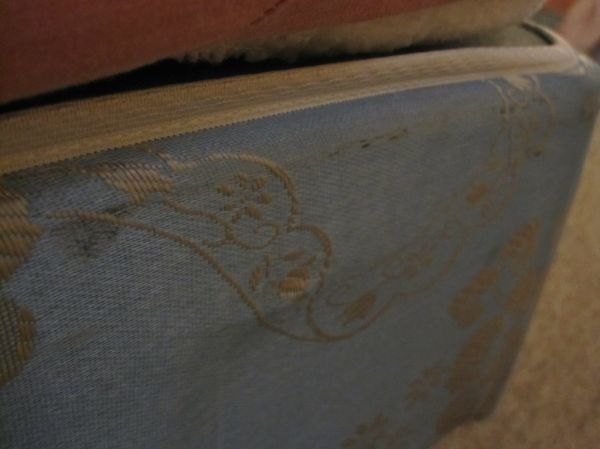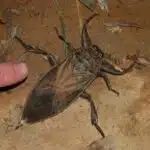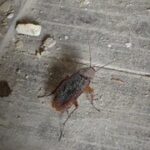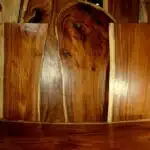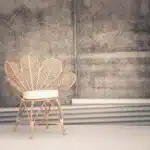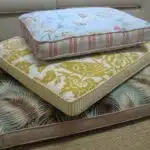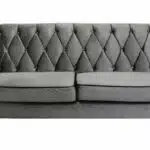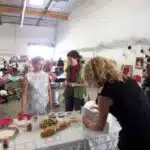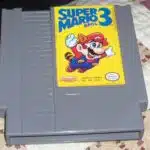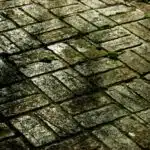Bed bugs are a common pest that infest homes and hotels, causing discomfort for those who encounter them. They are small, flat insects that feed on the blood of humans and animals while they sleep. One of the telltale signs of a bed bug infestation is the presence of their excrement, which can be found in various locations throughout a room. Identifying and cleaning bed bug stains is an important step in getting rid of these pests and preventing them from returning.
As an entomologist/pest control specialist, it is important to inform individuals about how to identify and clean bed bug stains. These stains can appear as dark spots or smears on bedding, furniture, walls, or floors. It is crucial to properly identify these stains as they can also be mistaken for other types of stains such as food or beverage spills. In this article, we will discuss how to accurately identify bed bug stains and provide tips for effective cleaning methods that will help prevent further infestations.
Understanding Bed Bugs And Their Behavior
Bed bugs are small, reddish-brown insects that feed on the blood of humans and animals. They are nocturnal pests, which means they are active at night and prefer to hide during the day. Understanding bed bug behavior is crucial in preventing infestations.
Bed bugs commonly infest areas where people sleep or rest for extended periods, such as beds, couches, and chairs. These pests can enter homes through secondhand furniture, luggage, clothing, or other personal belongings. Bed bugs can also travel from one room to another through walls and electrical outlets.
Prevention measures include regular inspections of sleeping areas and surrounding furniture for signs of bed bug activity. It is essential to thoroughly inspect secondhand items before bringing them into your home. Additionally, proper hygiene practices such as washing bedding and clothing regularly can help reduce the risk of bed bug infestations. By understanding bed bug behavior and taking preventative measures, you can minimize the risk of a bed bug infestation in your home.
As you become more familiar with bed bugs’ behavior patterns, it becomes easier to identify signs of an infestation early on. In the next section, we will discuss how to recognize these signs and what steps you can take to eradicate these pests from your home effectively.
Signs Of Bed Bug Infestation
Eggshells of bed bugs are white, oval and approximately 1 mm in length. Shed skins from bed bugs, which are referred to as cast skins, are empty exoskeletons left behind as bed bugs molt and grow. Fecal spots of bed bugs are often the first sign of an infestation and can appear as small black dots that bleed onto the surface when smashed. Musty odors are often present in infested locations due to the presence of pheromones produced by bed bugs. Bites from bed bugs are small and red and can appear in clusters or in a line. Blood spots on mattresses, bed sheets, and pillowcases are also indicative of bed bug infestations.
Eggshells
As an entomologist and pest control specialist, identifying bed bug eggshells is crucial in determining the extent of infestation. Bed bugs usually lay their eggs in hidden and secluded areas like cracks, crevices, and folds of fabric. These eggs are about 1mm long, white to yellowish in color, and shaped like a barrel with rounded ends. If you notice small translucent shells on fabrics or surfaces around your home, it is highly likely that you have a bed bug infestation.
Removing bed bug eggshells from fabrics can be challenging because they tend to adhere firmly to the material. The most effective way to get rid of them is by using a vacuum cleaner with a crevice tool or brush attachment. Ensure that you focus on all the seams, folds, tufts, and edges of the fabric where bed bugs are likely to lay their eggs. After vacuuming, immediately dispose of the contents of the vacuum bag or canister into a sealed plastic bag and throw it away.
It is important to note that removing bed bug eggshells alone may not eliminate an infestation entirely. You may need professional help from pest control specialists who will inspect your home thoroughly and use appropriate treatments to eradicate these pests completely. Therefore, if you suspect a bed bug infestation in your home despite your efforts to remove their eggshells, do not hesitate to seek professional assistance as soon as possible.
Shed Skins
As entomologists and pest control specialists, we know that identifying bed bug infestations requires a thorough understanding of their behavior and biology. In addition to eggshells, another sign of bed bugs in your home is the presence of shed skins or exoskeletons. Bed bugs undergo a molting process as they grow, shedding their outer layer to make room for new growth.
Bed bug exoskeletons are similar in appearance to live bugs, but they are translucent and empty. They are usually found near areas where bed bugs congregate, such as along baseboards or under mattresses. Like eggshells, these shed skins can be difficult to remove from fabrics and surfaces. However, they are an important clue that you have a bed bug infestation.
If you notice either bed bug eggshells or shed skins in your home, it is important to take action immediately. These signs indicate that there may be a significant population of bed bugs in your home, and they can quickly spread if left untreated. Contacting a pest control specialist is the best way to ensure that you eliminate these pests completely and prevent future infestations from occurring. Remember, early detection is key when it comes to controlling bed bugs!
Fecal Spots
As entomologists and pest control specialists, we know that bed bug infestations can be difficult to identify without a thorough understanding of their behavior and biology. In addition to eggshells and shed skins, another sign of bed bugs in your home is the presence of fecal spots. Bed bugs leave behind small brown or black stains on surfaces where they feed or rest.
It is important to note that not all brown spots on bedding are bed bug stains. However, if you notice these spots in conjunction with other signs such as live bugs, eggshells, or shed skins, it is likely that you have a bed bug infestation. Fecal spots are usually found near areas where bed bugs congregate, such as along baseboards or under mattresses.
If you discover fecal spots in your home, it is important to take action immediately. Not only are these stains unsightly and unpleasant to deal with, but they also indicate the presence of a significant population of bed bugs in your home. While it may be possible to remove some stains using household cleaners, it is best to contact a pest control specialist who can properly identify the source of the problem and eliminate all traces of bed bugs from your home. Remember, early detection and treatment are key when it comes to controlling bed bug infestations.
The Importance Of Identifying Bed Bug Stains
As a pest control specialist, it is crucial to understand the importance of identifying bed bug stains. Bed bugs are pesky little critters that can cause a lot of problems for people who are unlucky enough to have them in their homes. They feed on human blood and can leave behind unsightly and stubborn stains that are difficult to remove. To properly treat an infestation, it is essential to be able to identify these stains.
One of the most common detection techniques for bed bug stains is using a flashlight. These pests tend to hide in dark places such as cracks and crevices, making it difficult to spot them with the naked eye. By shining a bright light near areas where they may be hiding, you can easily detect any signs of staining left behind by these insects.
Another important technique for detecting bed bug stains is the use of specialized detection tools such as blue lights and sticky traps. These tools help in finding even the smallest traces of bed bugs or their waste products, making it easier to locate infestations and take appropriate action.
Overall, understanding the importance of identifying bed bug stains is crucial for effective pest control management. By using various detection techniques such as flashlights, blue lights, and sticky traps, pest control specialists can quickly identify the presence of these pests and take necessary steps towards eliminating them from homes and businesses alike. In the next section, we will discuss different types of bed bug stains that you might encounter during your inspections.
Types Of Bed Bug Stains
Bed bug infestations can be a daunting experience for anyone who has ever dealt with them. One of the tell-tale signs of bed bugs is their stains, which can appear on various surfaces like bed sheets, carpets, clothing, and furniture. Identifying these stains accurately is crucial in determining if an infestation exists and how severe it might be.
Differentiating fresh and old bed bug stains requires some level of expertise since they may look similar at first glance. Fresh bed bug stains are usually reddish or brownish in color due to the blood that the bugs extract from their hosts while feeding. These stains will typically have a wet appearance since they are still relatively new. Old bed bug stains, on the other hand, tend to be darker in color and may even have a black hue to them. They may also appear more dry and flaky than fresh ones.
Removing bed bug stains from carpets can be challenging but not impossible. The key is to act swiftly when you notice the stain so that it doesn’t settle into the fibers of the carpet. Start by using a clean cloth to blot up as much of the stain as possible without rubbing it in any further. Then apply a mixture of water and dish soap to the affected area and let it sit for about 30 minutes before rinsing thoroughly with cold water. If this method does not work, you may want to try using a commercial carpet cleaner specifically designed for removing tough stains.
Identifying and removing bed bug stains is just one aspect of dealing with an infestation effectively. In the next section, we will delve into how to properly identify bed bug stains so that you can take appropriate action if needed. Understanding what to look for and how to react quickly can help prevent further infestations from occurring in your home or business premises.
How To Properly Identify Bed Bug Stains
To truly understand the extent of bed bug infestation, one must be able to identify their stains. As the saying goes, “the devil is in the details.” Bed bugs leave behind two types of stains: fecal and bloodstains. Identifying these stains can help determine whether there is a bed bug infestation or not.
To identify bed bug fecal stains, look for small dark spots on surfaces such as mattresses, box springs, or sheets. These stains are typically grouped together and may resemble ink marks. The color can range from black to brown depending on how old they are. Cleaning these stains requires a gentle approach to avoid spreading them further. Use a damp cloth with mild soap to wipe away the stain gently.
Bed bug bloodstains are usually found after crushing or smashing the insect during feeding time. They can appear as red or rust-colored spots on surfaces like bedding or upholstered furniture. When cleaning these types of stains, use a damp cloth with cold water and mild soap to prevent setting the stain into the fabric. Avoid using hot water as this could cause the stain to become permanent.
Moving forward it is important to take note of common mistakes made when identifying bed bug stains in order to ensure accuracy in detection and successful treatment if necessary.
Mistakes To Avoid When Identifying Bed Bug Stains
The proper identification of bed bug stains is essential for successful bed bug control. Not using a flashlight to inspect the suspected area is a mistake to avoid, as often times bed bug stains are hidden in crevices and corners. Inspecting furniture, mattresses and bedding should be done with a magnifying glass to ensure all stains are identified. Bed bug traps should also be used to identify if an area is infested with bed bugs or not.
Not Using A Flashlight
When conducting a bed bug inspection, it is crucial to avoid making certain mistakes that can compromise the identification process. One of these errors is not using a flashlight. Bed bugs are nocturnal pests and typically hide in dark places during the day, making them difficult to spot with the naked eye. Without proper lighting, bed bug stains can be easily missed or mistaken for other types of stains.
To avoid this mistake, alternative detection methods can be used in conjunction with a flashlight. For instance, one can use an interception device or sticky traps to capture bed bugs and their shed skins. Another method involves using a black light or UV flashlight to detect bed bug fecal matter and cast skins as they glow under ultraviolet light. By combining these methods with proper lighting, one can accurately identify bed bug stains without missing any signs of an infestation.
In summary, when identifying bed bug stains, it is important to avoid the mistake of not using a flashlight. Alternative detection methods such as interception devices, sticky traps, and black lights can be employed alongside proper lighting to enhance accuracy in identifying bed bug infestations. By utilizing these techniques, pest control professionals and homeowners alike can effectively combat bed bugs and prevent further spread of infestations.
Not Inspecting Furniture
Common mistakes can be made when identifying bed bug stains, which can compromise the overall inspection process. One such mistake is not inspecting furniture. Bed bugs are known to infest furniture, especially ones with crevices and cracks, making them a prime hiding spot for these pests. Failure to inspect furniture thoroughly can result in missed signs of an infestation and ultimately lead to a more severe problem.
Preventive measures should be taken when conducting an inspection to avoid this mistake. A comprehensive inspection should include checking all furniture, including beds, couches, chairs, and even dressers and nightstands. The use of tools such as screwdrivers or flashlights can aid in examining hard-to-reach areas. By taking the time to inspect all potential hiding spots for bed bugs, one can accurately determine the extent of the infestation.
In addition to inspecting all furniture thoroughly, it is important to take preventive measures against bed bugs altogether. Regular cleaning and vacuuming of furniture and surrounding areas can help prevent bed bug infestations from occurring in the first place. Furthermore, purchasing encasements for mattresses and box springs can also provide added protection against bed bugs. By implementing these measures alongside proper inspections, one can effectively combat bed bug infestations before they become a larger problem.
Preparing For Cleaning Bed Bug Stains
Before you start cleaning bed bug stains, it is crucial to prepare for the task. The first step is to get rid of any live bed bugs and prevent a re-infestation. This can be done by using effective insecticides or consulting with a pest control specialist. It is important to note that cleaning alone will not eliminate bed bugs, as they can survive without feeding for up to a year.
Once you have ensured that there are no live bed bugs in your space, it’s time to choose the right products for cleaning. It is best to use products specifically designed for killing bed bugs and their eggs, such as sprays or powders. Be sure to read the label carefully and follow the instructions closely. Avoid using harsh chemicals or DIY remedies, as these may be ineffective and potentially harmful.
Remember that cleaning bed bug stains is just one part of the process towards eliminating an infestation. In addition to using effective cleaning products, it is important to take preventive measures such as regularly vacuuming your space and encasing your mattress and box spring in special covers designed for bed bug protection. By being proactive and thorough in your approach, you can successfully get rid of bed bugs and prevent future infestations from occurring.
Transition: Now that you have prepared for cleaning bed bug stains by getting rid of live insects and choosing appropriate products, let’s discuss the tools and materials needed for this task.
Tools And Materials Needed For Cleaning Bed Bug Stains
To properly clean bed bug stains, it is essential to have the right tools and materials. The following items are necessary for effective cleaning:
- Gloves: Wearing gloves will prevent direct contact with bed bugs and their excrement.
- Vacuum cleaner: Use a vacuum cleaner to remove any visible bed bug debris on surfaces such as carpets, furniture, and curtains.
- Sanitizing solutions: A variety of sanitizing solutions including alcohol-based cleaners and bleach can be used to effectively sanitize surfaces.
When using sanitizing solutions, it is critical to follow the manufacturer’s instructions carefully. Some products may require dilution before use or have specific application methods. Additionally, proper ventilation should be maintained when using these products to avoid inhaling toxic fumes.
While cleaning techniques may vary depending on the severity of the infestation and material of the surface being cleaned, it is important to take a thorough approach in order to prevent future bed bug infestations. By following these guidelines and regularly sanitizing surfaces in your home, you can feel confident that you are taking steps towards eradicating bed bugs from your living space.
Transitioning into the subsequent section about effective cleaning methods for bed bug stains on fabrics, we will discuss how to safely remove stains without damaging delicate fabrics.
Effective Cleaning Methods For Bed Bug Stains On Fabrics
After gathering all the necessary tools and materials for cleaning bed bug stains, it is now time to focus on the most effective cleaning methods. Bed bug infestations can be a nightmare for homeowners, particularly when it comes to removing stubborn stains from fabrics. However, with the right cleaning solutions and stain removal techniques, you can easily eradicate these pesky bugs from your home.
When it comes to cleaning bed bug stains from fabrics, always start by vacuuming the area thoroughly. This will help remove any visible signs of bed bugs and their eggs. Once you have finished vacuuming, apply a high-quality cleaning solution that is specifically designed for bed bug stains. These solutions are available in various forms such as sprays and powders and are highly effective in removing even the toughest of stains.
For more stubborn bed bug stains on fabrics, you may need to use specialized stain removal techniques such as steam cleaning or dry cleaning. Steam cleaners use high-temperature water vapor to penetrate deep into fabric fibers and kill any remaining bed bugs along with their eggs. On the other hand, dry-cleaning uses solvents to dissolve tough stains without damaging delicate fabrics.
Effective cleaning methods for bed bug stains on hard surfaces are equally important in preventing re-infestation of your home. In the next section, we will explore some proven techniques for removing stubborn bed bug stains from various surfaces such as walls, floors, and furniture.
Effective Cleaning Methods For Bed Bug Stains On Hard Surfaces
Cleaning Techniques for Bed Bug Stains on Hard Surfaces
When it comes to bed bug stains on hard surfaces, the best approach is to act quickly and effectively. There are various cleaning techniques that can be used to remove these pesky stains, including vacuuming, steam cleaning, and using stain removal products. Vacuuming is an effective method for removing bed bug stains from hard surfaces such as floors or walls. It helps to remove any debris or eggs left behind by the bugs.
Steam cleaning is another effective technique that can be used to remove bed bug stains from hard surfaces. The high temperature of the steam kills off any remaining bugs or eggs while also removing the stain. Additionally, there are various stain removal products that can be used to treat these stains. It’s important to choose a quality product that will not damage the surface being cleaned.
In summary, there are several effective cleaning techniques for removing bed bug stains on hard surfaces. Vacuuming and steam cleaning are both great options for those looking to tackle this issue themselves. Additionally, choosing a quality stain removal product can also aid in the process of removing these unsightly marks. With the right tools and techniques at your disposal, you can effectively remove bed bug stains from your home and prevent further infestations.
Looking for tips on preventing future bed bug infestations? Read on for some helpful advice!
Tips For Preventing Bed Bug Infestations
While bed bugs are certainly a nuisance, preventing infestations is relatively straightforward if you take the right precautions. One common objection to preventive measures is that they may be too time-consuming or expensive. However, investing in early detection and prevention measures can actually save you time and money in the long run by avoiding costly extermination services.
To prevent bed bug infestations, there are several preventive measures you can take. First and foremost, it’s important to inspect second-hand furniture before bringing it into your home. Another key preventative measure is to regularly vacuum carpets and upholstered furniture, as well as launder bedding on high heat settings. Additionally, sealing cracks and crevices around baseboards, windowsills, and door frames can also help prevent bed bugs from entering your home.
Early detection is also crucial for preventing major infestations. Some signs of a bed bug infestation include blood stains on sheets or pillows, dark spots (bed bug feces) on bedding or walls, and an unpleasant musty odor in the room. By identifying these signs early on, you can take action before the problem gets out of hand.
Transition: While preventive measures can go a long way in keeping bed bugs at bay, sometimes calling in a professional exterminator is necessary. In the next section, we’ll discuss when it’s appropriate to seek professional help and what to expect during the extermination process.
When To Call A Professional Exterminator
Signs of a bed bug infestation can be difficult to identify, as these pests are experts at hiding in small cracks and crevices. However, some common signs include small blood stains on your bedding or furniture, dark spots (bed bug feces) on your sheets or mattress, and the presence of live bed bugs or their shed skins. If you suspect you have a bed bug problem, it is important to act quickly to avoid further infestation.
While there are DIY methods for treating bed bugs, such as using insecticides and vacuuming frequently, these methods may not be effective in eliminating the entire population. Professional exterminators have access to stronger chemicals and specialized equipment that can effectively eradicate bed bugs from your home. Additionally, they can provide helpful advice on how to prevent future infestations. However, it is important to consider the costs associated with professional extermination services.
One drawback of hiring a professional exterminator is the cost. These services can be expensive, but they may be worth the investment if you have a severe infestation that cannot be eliminated by other means. Another potential drawback is the need to vacate your home during treatment, which can be inconvenient and disruptive to your daily life. Ultimately, the decision to hire a professional exterminator will depend on the severity of your infestation and your budget constraints.
Transition: Now that you understand the benefits and drawbacks of hiring a professional exterminator for dealing with bed bugs, it’s important to also consider safety precautions when handling cleaning products and pesticides around these pests.
Safety Precautions When Dealing With Bed Bugs And Cleaning Products
When dealing with bed bugs, protective gear is essential for safety. Cleaning products should be carefully considered to avoid exacerbating the issue. Understanding the bed bug lifecycle is important for successful sanitizing and disposal of debris. Killing bed bugs, preventing reinfestation, and bed bug treatments are all important steps in the process, as well as vacuuming, using insecticides, detecting bed bugs, bed bug proofing, eliminating accumulated dust, and using insect growth regulators for prevention.
Protective Gear
Bed bugs are a nightmare for anyone who has ever dealt with them. These tiny pests can hide in the tiniest of crevices and reproduce at an alarming rate, causing sleepless nights and skin irritation. However, dealing with bed bugs requires taking safety precautions, especially when using cleaning products. One of the most important safety measures is wearing protective gear.
Protective gear is essential when dealing with bed bugs as it protects you from coming into contact with harmful chemicals found in cleaning products. This gear includes gloves, goggles, respirators, and long-sleeved clothing to cover your skin. When using cleaning techniques such as sprays or powders, it’s crucial to protect yourself from inhaling or touching these chemicals as they could cause irritation or even harm your health.
When choosing protective gear, ensure that you select appropriate equipment for the specific task at hand. For instance, use gloves made of material that does not allow chemicals to seep through to your skin. Additionally, always wear a respirator that filters out airborne particles to protect your lungs from dust or fumes generated during the cleaning process. By following these safety precautions and using proper protective gear when handling cleaning products, you can effectively deal with bed bugs without risking your health.
In conclusion, protecting yourself when dealing with bed bug stains is critical for your safety and well-being. Always use protective gear when using cleaning techniques to avoid contact with harmful chemicals found in cleaning products. Choose the right equipment for each task and follow instructions on labels carefully to ensure safe usage. With these precautions in place, you can tackle bed bug infestations without putting yourself at risk of harm from exposure to hazardous substances found in some cleaning agents.
Cleaning Products
As entomologists and pest control specialists, we understand that dealing with bed bugs can be challenging. It’s crucial to take safety precautions when using cleaning products to avoid exposure to harmful chemicals that may cause health risks. However, some natural alternatives and DIY solutions are available for those who prefer not to use chemical-based products.
One of the most effective natural alternatives is heat treatment. Bed bugs cannot survive in high temperatures, so exposing infested items to heat can eliminate them without the need for chemicals. Another option is using essential oils such as tea tree oil or lavender oil, which have insecticidal properties that repel bed bugs. Essential oils can be mixed with water and sprayed on infested areas or added to laundry detergent during washing.
DIY solutions such as steam cleaning and vacuuming are also effective in eliminating bed bugs. Steam cleaning exposes bed bugs to high temperatures that kill them instantly, while vacuuming removes adult bed bugs and their eggs from surfaces. These methods are safe and do not require the use of chemicals, making them an excellent option for individuals concerned about their health when handling cleaning products.
Common Myths And Misconceptions About Bed Bugs
As a pest control specialist, it’s important to address common bed bug myths and debunk misconceptions. For example, many people believe that bed bugs only infest dirty homes or hotels, but this is simply not true. Bed bugs can thrive in any environment, regardless of cleanliness. Additionally, some people think that bed bugs are too small to see with the naked eye, but they are actually visible to most people.
Another myth about bed bugs is that they only bite at night. While it’s true that they are nocturnal insects and prefer to feed when their host is asleep, they will bite during the day if given the opportunity. It’s also important to note that not everyone will have a reaction to bed bug bites, so it’s possible to have an infestation without even realizing it.
When it comes to identifying and cleaning bed bug stains, there are some misconceptions as well. Many people think that bleach will kill bed bugs and their eggs on contact, but this is not true. Bleach may kill some of the bugs on contact, but it won’t eliminate an entire infestation. Additionally, some people believe that steam cleaning will get rid of all the bugs and eggs in their home, but this method has limitations as well.
In conclusion, it’s crucial for pest control specialists to educate themselves and their clients about common bed bug myths and misconceptions. By dispelling these falsehoods and providing accurate information about identifying and cleaning bed bug stains, we can help prevent the spread of infestations and ensure effective treatment methods are used. With proper education and preventative measures in place, we can work towards eliminating these pesky insects from our homes and businesses for good.
Final Thoughts On Identifying And Cleaning Bed Bug Stains
Bed bug infestations can be a nightmare for homeowners, causing sleepless nights and anxiety. One of the most common signs of bed bugs is their stains on bedding or furniture. However, identifying these stains can be tricky, and cleaning them even more so. In this section, we will discuss some final thoughts on identifying and cleaning bed bug stains.
Cleaning techniques for bed bug stains vary depending on the severity of the infestation. For minor cases, DIY methods such as vacuuming, washing bedding in hot water, and using steam cleaners can be effective. However, for severe infestations, it is recommended to seek professional help from pest control specialists who use specialized equipment and treatments to eliminate bed bugs.
When deciding between DIY and professional cleaning techniques, it is important to consider the level of infestation and your own capabilities. DIY methods may save money but may not completely eliminate bed bugs, leading to a reinfestation down the road. Professional cleaning can be more expensive but offers a higher chance of complete elimination.
In conclusion, identifying and cleaning bed bug stains requires careful attention to detail and proper techniques to avoid further spreading of the infestation. Understanding when to use DIY methods versus seeking professional help can make all the difference in eradicating these pesky pests from your home. Remember that prevention is key in avoiding future infestations by regularly inspecting bedding, furniture, and luggage after traveling.
Conclusion
Bed bugs are a common nuisance that can quickly turn into a major infestation if left unchecked. Identifying bed bug stains is an important step in controlling their spread in your home. By understanding the behavior of bed bugs, you can learn to recognize their signs and take the necessary steps to eliminate them.
There are several types of bed bug stains that you should be aware of, including fecal stains, blood stains, and shed skins. These stains can be found on bedding, furniture, and other areas where bed bugs may be present. It is important to properly identify these stains so that you can take appropriate action to clean and treat the affected area.
According to recent studies, nearly 97% of pest control professionals have treated bed bug infestations in the past year. This statistic highlights the prevalence of this problem and underscores the importance of taking proactive measures to prevent it from occurring in your own home. By following proper cleaning procedures and seeking professional help when needed, you can keep your home free of bed bugs and other pests. Remember to always take safety precautions when dealing with cleaning products or insecticides, as they can pose a risk if not used properly.
Image Credits
- “Confirmed — NOT bed bug staining” by carpet.beetle (featured)

